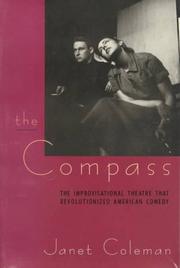| Listing 1 - 10 of 350 | << page >> |
Sort by
|
Book
ISBN: 9782336001760 Year: 2012 Publisher: Paris : L'Harmattan,
Abstract | Keywords | Export | Availability | Bookmark
 Loading...
Loading...Choose an application
- Reference Manager
- EndNote
- RefWorks (Direct export to RefWorks)
Après une définition de l'improvisation en général et de son rôle dans la constitution de la civilisation, l'auteur se focalise sur l'improvisation dans le domaine musical et ses relations avec la composition.
Book
ISBN: 9781138992412 Year: 2016 Publisher: New York, NY Routledge
Abstract | Keywords | Export | Availability | Bookmark
 Loading...
Loading...Choose an application
- Reference Manager
- EndNote
- RefWorks (Direct export to RefWorks)
In presenting their comprehensive definition of improvisation, the authors consider developments in improvisation in the arts since 1945 by particularly emphasizing process and technique and by featuring artists in all media, from Grotowski and Laurie Anderson to Goldsworthy. Their approach is analytical and theoretical, but it is also relevant to practitioners and their audience. For Smith and Dean, improvisation has been of great importance and value in the contemporary arts because of its potential to develop new forms, often by breaking existing definitions: they see hypermedia and interactive technologies as playing a key role in dissolving the audience/creator separation which exists especially in Western society, though often less in other cultures.
Improvisation (Acting) --- Improvisation (Music) --- Improvisation in art

ISBN: 0226113450 9780226113456 Year: 1991 Publisher: Chicago: University of Chicago press,
Abstract | Keywords | Export | Availability | Bookmark
 Loading...
Loading...Choose an application
- Reference Manager
- EndNote
- RefWorks (Direct export to RefWorks)
Janet Coleman brilliantly recreates the time, the place, the personalities, and the neurotic magic whereby the Compass made theater history in America. The Compass began in a storefront theater near the University of Chicago campus in the summer of 1955 and lasted only a few years before its players—including David Shepherd, Paul Sills, Elaine May, Mike Nichols, Barbara Harris, and Shelley Berman—moved on. Out of this group was born a new form: improvisational theater and a radically new kind of comedian. "They did not plan to be funny or to change the course of comedy," writes Coleman. "But that is what happened."

ISBN: 1854596683 9781854596680 Year: 2006 Publisher: London: Nick Hern Books,
Abstract | Keywords | Export | Availability | Bookmark
 Loading...
Loading...Choose an application
- Reference Manager
- EndNote
- RefWorks (Direct export to RefWorks)

ISBN: 0878301631 9780878301638 Year: 1979 Publisher: New York: Theatre arts books,
Abstract | Keywords | Export | Availability | Bookmark
 Loading...
Loading...Choose an application
- Reference Manager
- EndNote
- RefWorks (Direct export to RefWorks)
Book
ISBN: 9780415551014 9780415551021 9780203872413 Year: 2009 Publisher: New York, NY : Routledge,
Abstract | Keywords | Export | Availability | Bookmark
 Loading...
Loading...Choose an application
- Reference Manager
- EndNote
- RefWorks (Direct export to RefWorks)
Book
Year: 1969 Publisher: Purmerend : Muusses,
Abstract | Keywords | Export | Availability | Bookmark
 Loading...
Loading...Choose an application
- Reference Manager
- EndNote
- RefWorks (Direct export to RefWorks)
Book
ISBN: 9789616572415 9616572415 Year: 2015 Publisher: Ljubljana : Kolektiv Narobov : Zavod Federacija : Maska,
Abstract | Keywords | Export | Availability | Bookmark
 Loading...
Loading...Choose an application
- Reference Manager
- EndNote
- RefWorks (Direct export to RefWorks)
Book
ISBN: 2940516642 2940516626 Year: 2016 Publisher: Lausanne, Switzerland : BSN Press,
Abstract | Keywords | Export | Availability | Bookmark
 Loading...
Loading...Choose an application
- Reference Manager
- EndNote
- RefWorks (Direct export to RefWorks)
Comment se réalise une improvisation ? À quelles conditions peut-on dire d'une improvisation qu'elle est réussie ? Doit-on définir une spécificité de l'improvisation pour chaque pratique de l'art, comme pour le théâtre, le cinéma, la musique et la performance ? Comment distinguer les pratiques artistiques, comme un morceau de jazz, et les pratiques quotidiennes, comme une conversation ? Autant de questions qui traversent ce livre. Ce recueil de textes découle d'un projet de recherche collectif sur l'improvisation, entre artistes et différents chercheurs en esthétique et en sciences sociales. De 2013 à 2015, quatre écoles d'art se sont réunies : la Manufacture pour le théâtre, la Haute école de musique de Lausanne pour la musique, l'École cantonale d'art de Lausanne pour le cinéma, et la Haute école d'art et de design de Genève pour la performance.
Book
Year: 2022 Publisher: Berlin ; Boston : De Gruyter,
Abstract | Keywords | Export | Availability | Bookmark
 Loading...
Loading...Choose an application
- Reference Manager
- EndNote
- RefWorks (Direct export to RefWorks)
This study originates in the observation that improv comedy or improvised theater has such a vast majority of white people practicing it, while other improvisational or comedic art forms (jazz, freestyle rap, stand up) are historically grounded in and marked as Black cultural production. What it is about improv that makes it such a white space? Can an absence be an object of study? If so, what is there to study? Where should one look?.
| Listing 1 - 10 of 350 | << page >> |
Sort by
|

 Search
Search Feedback
Feedback About UniCat
About UniCat  Help
Help News
News